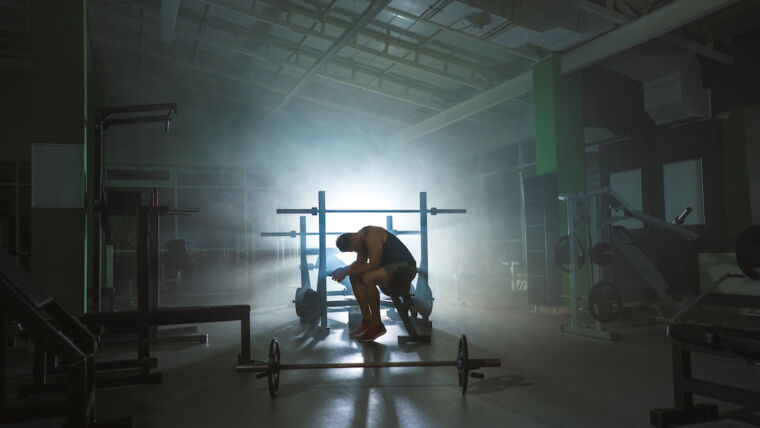Have you ever felt like your best performances are in practice? Do you ever think to yourself, “If I could just pole vault in a meet the way that I do in practice, I would crush it!”? YOU ARE NOT ALONE. Competing is tough, and I would bet that many of the most elite vaulters succumb to the pressures of competition from time to time. It’s just a part of sport, but if you can harness that nervous energy and channel it in the right direction, it can propel you to a level you never thought possible. Below are some wise words from an email written to his athletes on seven problems that he has seen over the years pertaining to competition anxiety, by RISE coach Tim Winder (CW).
Quick note before you read on – It is very important to be honest with yourself and see if there are any of these aspects you could improve on. You need to recognize your flaws, accept your flaws, and then take steps to change them.
Problem #1: Legs feel fatigued during competition
This is mostly from anxiety. If you are a well trained athlete, your legs can’t become fatigued from running down a 140 foot runway a few times. Anxiety causes fatigue. I am sometimes an example of this after I coach. I am really tired when I get home. However all I did was watch pole vaulting for a few hours. I should not be fatigued, but I am because of the anxiety that I felt in competition. I don’t always feel this way, but do when I impose this stress/anxiety on myself when trying to help someone compete well.
Problem #2: Jumping on emotion.
I love to compete against teams that jump on emotion. I like this because I know that their emotions will run out after a couple bars, and then we will take over. I’ve seen this happen time and time again. I’m not saying don’t jump with emotion. I’m saying don’t jump using emotion as your fuel. Your tank is very small on emotion. Those vaulters usually make a bar and then crap out. Big difference between jumping with emotion, which is good, and jumping on emotion which is bad.
Problem #3: Living in the past or future.
Living in the past, or always comparing yourself to what you “were”, and living in the future, which is always thinking that you are not where you want to be, is a slippery slope. Yes… you can learn from the past, but as soon as you have identified what you can learn, then dismiss the past and start pressing forward. Yes… you do need goals in the future, but as soon as you identify these goals, dismiss them and focus on the present, which is what you are in control of right now. You won’t reach a goal by wanting it, you’ll reach it by the work that you do now, in this moment, today. Comparison is the worst thing that a human can do. Everyone has issues. No one is perfect. No one’s family, life, or performance is perfect, regardless of how they make it look on social media. So… get over it and live inside your life, and vault, now.
Problem #4: Focusing on the outcome you want in the competition.
It is my experience that all vaulters want to have a personal best everyday. I understand this, but that desire is an unhealthy one. The only way to get what you desire is to rid yourself of your unhealthy desire and focus on the healthy desire. By the way… outcome orientation is unhealthy and immersion in the technical process from the first step down the runway until you hit the pit is a healthy desire.
Problem #5: Talking too much.
I have seen this one undermine performance over and over in my 32 years of coaching the vault. Vaulters who nervously talk to much are fixing to have a less than optimal performance. I’m not saying not to be nice and communicate with me and other athletes. I’m saying… don’t let out energy by verbalizing too much. That is usually nervous energy that is being released and could be harnessed and utilized in the competition. Also… don’t ever, ever, say…. “This is gonna be the day”, or something along those lines. More times than not… after saying that, it’s not going to be your day. The worst thing for me, is to hear an athlete say something like that after a good warm up. I’m usually thinking in my head after a statement like that…well… you just sealed that deal, and the deal is usually a less than optimal performance. That is because you just needlessly put pressure on yourself by making a prediction that will be turned into a pressure cooker the first time you get stood up at a bar. This will cause self-doubt. You have immersed yourself in the self-doubt trough of failure. Keep it zipped, and you might immerse yourself in the baptismal of the technical process.
Problem #6: Being tense.
I loath showing up to a meet, looking at my athlete/vaulter, and not knowing who they are. This has happened often in my years. Someone else shows up to the meet. Someone with their own ideas, agenda, and orientation. This stranger is always tense, always very verbal, less likely to listen, and has their own, oftentimes snippy personal agenda. These pseudo vaulters remind me of Phaedrus in Zen and the Art of Motorcycle Maintenance. A classic book that is way up on my reading list. This situation is always a failure in performance, and most times leads to a breakdown in communication between me and the athlete. If a pseudo vaulter shows up at a competition, it is oftentimes the most frustrating of situations for me, because my data is on the other vaulter, not the pseudo vaulter. My vaulting intellect is of no use to the pseudo vaulter, and honestly they’d be better off if I went home, and someone else caught their step.
Problem #7: No….Please no more pole vaulting epiphanies!!!!
Pole vaulting novices and fans have epiphanies. I am neither of those, nor should you be. Over the years I’ve had many vaulters who can “come up with” something that they think will work better than the way I’ve taught them. Usually this happens after a vaulter has reached a good level of success, so they think that their 4-8 years of experience of being a vaulter can trump my 45 years of being involved in the vault, and instructing 1000’s of young people over 32 years of year round vaulting, from ages junior high through post-collegiate. I say this with all do respect…. “You don’t know as much about all the aspects of vaulting as I do.” After putting in time, you may one day know more, and that would make me very happy, but for now… learn what is being taught, bottom to top, all the pillars of the temple of performance. After you can state and execute all that, then… if you have a pole vaulting epiphany, I’ll listen. But… remember… I’ve seen a lot of pole vaulting BS come and go since the 1970’s, so be prepared for your epiphany to run out of air in a while. Then, you’ll be left laying face down on the steps of the “Temple of Performance”, wondering, why you ever left and how do you get back in. Little has been discovered about how to perform at a high level in the vault since the start of fiberglass poles. Nothing new has been discovered since Vitaly Petrov and Sergei Bubka. Petrov’s ideas about the approach run up and training is what changed vaulting. Petrov had an epiphany. It was a good one. He could make it work because he coached for the Soviet Union and he developed his epiphanies on young talented kids who were selected because of their physical and mental attributes. He was perhaps the final vaulting epiphany. You are not. Learn to execute my way, which essentially is built off of the foundation of the “Final Pole Vaulting Epiphany.”
The Pseudo vaulter (looking for a pole vaulting epiphany) is always….
1. Chatty
2. Physically tense
3. Outcome oriented
4. Emotional
5. Comparing themselves to others
6. Looking for an easier way
Characteristics of a good competitor and competitive response:
1. Recovers and relaxes physically between jumps.
2. Recovers emotionally between jumps.
3. Lives in the moment.
4. Immerses themselves in the technical process of how we jump.
5. Contains still, quiet, focus which manifests itself in few words.
6. Is physically relaxed.
7. Is immersed in the RISE Level system of pole vaulting.
Done.
-CW




